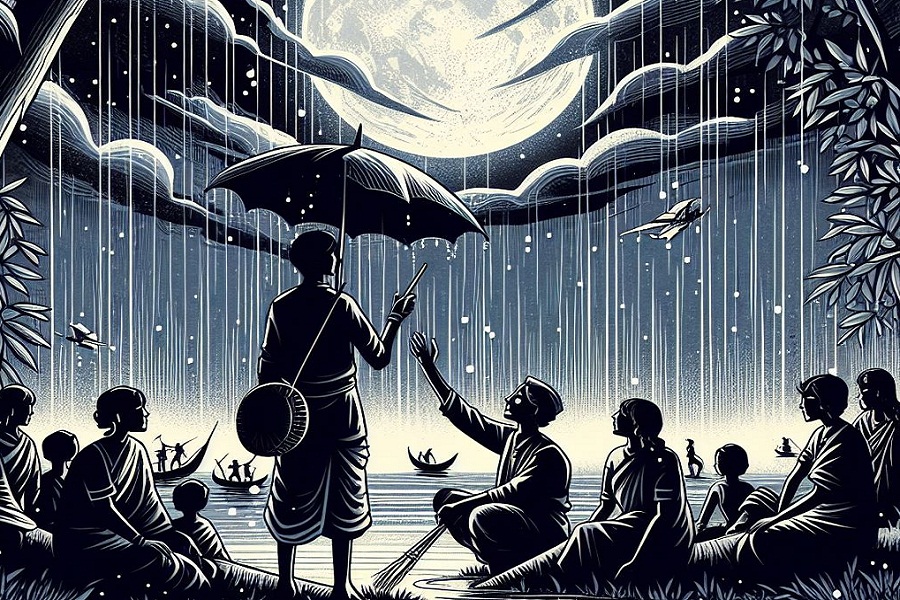
Published :
Updated :

Yearning for rain is a timeless feeling. The expression may evolve over the centuries, but the anticipation is evergreen. Rainstorms have fascinated the romantic, humbled the brave, scared the religious, blessed the farmer, and demolished the homeless. Rain has been integral to humankind's folktales for thousands of years. Folklores and mythologies shaped our thoughts and experiences of the events happening around us, such as rain. From religion-based stories to poetry, we grew up listening to rain and thunder stories.

They are popular and interestingly related to one another. These stories will leave you wandering into the riveting plot even after you finish. How is rain associated with the folktales of the Bengal Delta? And how do different mythologies see rain? Let's learn through this beautiful story.
Rain folktales in Bengal—a rural land where rain is tied to agriculture, livelihood, flooding, and destruction—have different perspectives. 'The curse of buri rani' tells the story of a beautiful queen who was arrogant and treated her subjects poorly. As punishment, she was cursed to wander the earth eternally as a storm, bringing heavy rains and floods.
'The Hilsa Fish and the Rain Spirit' is set in the fertile lands around the Padma River, where a fisherman catches a rain spirit disguised as Hilsa during a heavy downpour. The spirit pleads for life, and fearing the wrath of the river goddess, the farmer lets him go. In return, the spirit ensures a bountiful Hilsa catch every monsoon, highlighting the connection between rain, the river, and the community's well-being.
In ancient mythology, various cultures often associated specific deities with rainfall, fertility, and agricultural abundance. For example, in Vedic mythology, Indra is usually depicted as the bringer of rain and storms. Indra rides an elephant named Airavata and it carries all the rain in its seven trunks. It sprinkles water to the clouds and Indra hits thunder into the clouds. Only then does rain occur. Varun is a god of ocean, sky, and water. Surupa is a sky goddess who brings rain. Varshini is the goddess who brings drizzle from heaven. Parjanya is a Vedic deity of rain, thunder, lightning, and the one who fertilizes the earth. Mariamman- some say the reincarnation of Dhrupadi is a deity of weather deeply venerated in rural South India.

In Greek mythology, Zeus is associated with thunder and rain. Hyades, a sisterhood of water nymphs, carry the rainwater to earth at Zeus's command. He controls the weather and uses a thunderbolt to warn mortals of his displeasure. He would also cause famine as a form of punishment for not praying to him.
In Philippine mythology, Pamulak Manobo—the supreme deity and creator of the land, sea, and the first humans—throws water from the sky, causing rain, while his spits are the showers. He controls good harvest, rain, wind, life, and death. Adad is a Mesopotamian god equated with Zeus or Indra. Kuraokami, or Okami, is a legendary Japanese dragon and Shinto deity of rain and snow.
In China, a dragon named Yinglong was associated with water and rain. Yinglong gives enough rain to nourish the earth but sends floods or withholds rain if he feels dishonored.
Fertility rituals involving animals or symbolic unions may have existed in ancient societies to invoke blessings for agricultural prosperity, e.g., frog marriages. However, a tale involving frogs takes a dark turn in Korea. Two frog brothers do the opposite of what their mother says. To avoid such contrariness, the dying mother, wishing to be buried on the sunny side of a hill, requested her sons to bury her in the shade by the stream.
Well, this time, they obeyed her last wish. So whenever it rains, they beg the rain god not to drown their mother's grave, and ever since then, green frogs sit by streams and cry while raining. Looking at the sky with much anticipation for rain is a universal sign.


 For all latest news, follow The Financial Express Google News channel.
For all latest news, follow The Financial Express Google News channel.